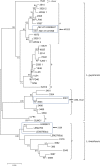New insights into the genetic diversity of Leishmania RNA Virus 1 and its species-specific relationship with Leishmania parasites
- PMID: 29912912
- PMCID: PMC6005476
- DOI: 10.1371/journal.pone.0198727
New insights into the genetic diversity of Leishmania RNA Virus 1 and its species-specific relationship with Leishmania parasites
Abstract
Cutaneous leishmaniasis is a neglected parasitic disease that manifests in infected individuals under different phenotypes, with a range of factors contributing to its broad clinical spectrum. One factor, Leishmania RNA Virus 1 (LRV1), has been described as an endosymbiont present in different species of Leishmania. LRV1 significantly worsens the lesion, exacerbating the immune response in both experimentally infected animals and infected individuals. Little is known about the composition and genetic diversity of these viruses. Here, we investigated the relationship between the genetic composition of LRV1 detected in strains of Leishmania (Viannia) braziliensis and L. (V.) guyanensis and the interaction between the endosymbiont and the parasitic species, analyzing an approximately 850 base pair region of the viral genome. We also included one LRV1 sequence detected in L. (V.) shawi, representing the first report of LRV1 in a species other than L. braziliensis and L. guyanensis. The results illustrate the genetic diversity of the LRV1 strains analyzed here, with smaller divergences detected among viral sequences from the same parasite species. Phylogenetic analyses showed that the LRV1 sequences are grouped according to the parasite species and possibly according to the population of the parasite in which the virus was detected, corroborating the hypothesis of joint evolution of the viruses with the speciation of Leishmania parasites.
Conflict of interest statement
The authors have declared that no competing interests exist.
Figures




Similar articles
-
Unraveling the genetic diversity and phylogeny of Leishmania RNA virus 1 strains of infected Leishmania isolates circulating in French Guiana.PLoS Negl Trop Dis. 2017 Jul 17;11(7):e0005764. doi: 10.1371/journal.pntd.0005764. eCollection 2017 Jul. PLoS Negl Trop Dis. 2017. PMID: 28715422 Free PMC article.
-
Tilting the balance between RNA interference and replication eradicates Leishmania RNA virus 1 and mitigates the inflammatory response.Proc Natl Acad Sci U S A. 2016 Oct 25;113(43):11998-12005. doi: 10.1073/pnas.1615085113. Epub 2016 Oct 18. Proc Natl Acad Sci U S A. 2016. PMID: 27790981 Free PMC article.
-
Further Evidence of an Association between the Presence of Leishmania RNA Virus 1 and the Mucosal Manifestations in Tegumentary Leishmaniasis Patients.PLoS Negl Trop Dis. 2015 Sep 15;9(9):e0004079. doi: 10.1371/journal.pntd.0004079. eCollection 2015. PLoS Negl Trop Dis. 2015. PMID: 26372217 Free PMC article.
-
Leishmania Viannia guyanensis, LRV1 virus and extracellular vesicles: a dangerous trio influencing the faith of immune response during muco-cutaneous leishmaniasis.Curr Opin Immunol. 2020 Oct;66:108-113. doi: 10.1016/j.coi.2020.08.004. Epub 2020 Aug 30. Curr Opin Immunol. 2020. PMID: 32877837 Review.
-
Leishmania (Viannia) guyanensis in tegumentary leishmaniasis.Pathog Dis. 2018 Jun 1;76(4). doi: 10.1093/femspd/fty025. Pathog Dis. 2018. PMID: 29722820 Review.
Cited by
-
Viruses of protozoan parasites and viral therapy: Is the time now right?Virol J. 2020 Sep 29;17(1):142. doi: 10.1186/s12985-020-01410-1. Virol J. 2020. PMID: 32993724 Free PMC article. Review.
-
The Maze Pathway of Coevolution: A Critical Review over the Leishmania and Its Endosymbiotic History.Genes (Basel). 2021 Apr 27;12(5):657. doi: 10.3390/genes12050657. Genes (Basel). 2021. PMID: 33925663 Free PMC article. Review.
-
Widespread, human-associated redondoviruses infect the commensal protozoan Entamoeba gingivalis.Cell Host Microbe. 2023 Jan 11;31(1):58-68.e5. doi: 10.1016/j.chom.2022.11.002. Epub 2022 Dec 1. Cell Host Microbe. 2023. PMID: 36459997 Free PMC article.
-
Raising the suspicion of a non-autochthonous infection: identification of Leishmania guyanensis from Costa Rica exhibits a Leishmaniavirus related to Brazilian north-east and French Guiana viral genotypes.Mem Inst Oswaldo Cruz. 2023 Jan 16;117:e220162. doi: 10.1590/0074-02760220162. eCollection 2023. Mem Inst Oswaldo Cruz. 2023. PMID: 36651455 Free PMC article.
-
Leishmania RNA Virus 1 (LRV-1) in Leishmania (Viannia) braziliensis Isolates from Peru: A Description of Demographic and Clinical Correlates.Am J Trop Med Hyg. 2020 Feb;102(2):280-285. doi: 10.4269/ajtmh.19-0147. Am J Trop Med Hyg. 2020. PMID: 31837129 Free PMC article.
References
-
- Hartley MA, Bourreau E, Rossi M, Castiglioni P, Eren RO, Prevel F, et al. Leishmaniavirus-Dependent Metastatic Leishmaniasis Is Prevented by Blocking IL-17A. PLoS Pathog. 2016;12: 1–19. doi: 10.1371/journal.ppat.1005852 - DOI - PMC - PubMed
-
- World Health Organization. Control of the leishmaniases. Control of the leishmaniasis: report of a meeting of the WHO Expert Committee on the Control of Leishmaniases. Geneva; 2010.
-
- Alvar J, Vélez ID, Bern C, Herrero M, Desjeux P, Cano J, et al. Leishmaniasis worldwide and global estimates of its incidence. PLoS One. 2012;7: e35671 doi: 10.1371/journal.pone.0035671 - DOI - PMC - PubMed
-
- Hartley M- A, Ronet C, Zangger H, Beverley SM, Fasel N. Leishmania RNA virus: when the host pays the toll. Front Cell Infect Microbiol. 2012;2: 99 doi: 10.3389/fcimb.2012.00099 - DOI - PMC - PubMed
-
- Brettmann EA, Shaik JS, Zangger H, Lye L, Kuhlmann FM. Tilting the balance between RNA interference and replication eradicates Leishmania RNA virus 1 and mitigates the inflammatory response. 2016; 1–8. doi: 10.1073/pnas.1615085113 - DOI - PMC - PubMed
Publication types
MeSH terms
Supplementary concepts
LinkOut - more resources
Full Text Sources
Other Literature Sources

